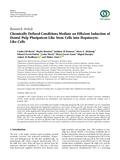Mostrar el registro sencillo del ítem
Chemically defined conditions mediate an efficient induction of dental pulp pluripotent-like stem cells into hepatocyte-like cells
| dc.creator | Gil-Recio, Carlos | es_ES |
| dc.creator | Montori, Sheyla | es_ES |
| dc.creator | Al Demour, Saddam | es_ES |
| dc.creator | Ababneh, Mera A. | es_ES |
| dc.creator | Ferrés-Padró, Eduard | es_ES |
| dc.creator | Marti, Carles | es_ES |
| dc.creator | Ferrés-Amat, Elvira | es_ES |
| dc.creator | Barajas Vélez, Miguel Ángel | es_ES |
| dc.creator | Al Madhoun, Ashraf | es_ES |
| dc.creator | Atari, Maher | es_ES |
| dc.date.accessioned | 2022-04-07T07:47:48Z | |
| dc.date.available | 2022-04-07T07:47:48Z | |
| dc.date.issued | 2021 | |
| dc.identifier.issn | 1687-9678 | |
| dc.identifier.uri | https://hdl.handle.net/2454/42684 | |
| dc.description.abstract | Liver diseases are major causes of morbidity and mortality. Dental pulp pluripotent-like stem cells (DPPSCs) are of a considerable promise in tissue engineering and regenerative medicine as a new source of tissue-specific cells; therefore, this study is aimed at demonstrating their ability to generate functional hepatocyte-like cells in vitro. Cells were differentiated on a collagen scaffold in serum-free media supplemented with growth factors and cytokines to recapitulate liver development. At day 5, the differentiated DPPSC cells expressed the endodermal markers FOXA1 and FOXA2. Then, the cells were derived into the hepatic lineage generating hepatocyte-like cells. In addition to the associated morphological changes, the cells expressed the hepatic genes HNF6 and AFP. The terminally differentiated hepatocyte-like cells expressed the liver functional proteins albumin and CYP3A4. In this study, we report an efficient serum-free protocol to differentiate DPPSCs into functional hepatocyte-like cells. Our approach promotes the use of DPPSCs as a new source of adult stem cells for prospective use in liver regenerative medicine. | en |
| dc.description.sponsorship | This study was funded by the Universitat Internacional de Catalunya (UIC), the Agència de Gestió d’Ajuts Universitaris i de Recerca, Generalitat de Catalunya project number (SGR 1060 for MA), the Kuwait Foundation for the Advancement of Sciences (KFAS), and the Dasman Diabetes Institute under project number (RA-2013-009 for AAM). CGR, EMS, and RNT were funded by the predoctoral grant Junior Faculty award from the Obra Social, 'la Caixa' Foundation, and UIC. | en |
| dc.format.extent | 14 p. | |
| dc.format.mimetype | application/pdf | en |
| dc.format.mimetype | application/zip | en |
| dc.language.iso | eng | en |
| dc.publisher | Hindawi | en |
| dc.relation.ispartof | Stem Cells International, Volume 2021, Article ID 5212852, 14 pages | en |
| dc.rights | © 2021 Carlos Gil-Recio et al. This is an open access article distributed under the Creative Commons Attribution License, which permits unrestricted use, distribution, and reproduction in any medium, provided the original work is properly cited. | es_ES |
| dc.rights.uri | http://creativecommons.org/licenses/by/4.0/ | |
| dc.subject | Dental pulp pluripotent-like stem cells (DPPSCs) | en |
| dc.subject | Hepatocyte-like cells | en |
| dc.title | Chemically defined conditions mediate an efficient induction of dental pulp pluripotent-like stem cells into hepatocyte-like cells | en |
| dc.type | info:eu-repo/semantics/article | en |
| dc.type | Artículo / Artikulua | es |
| dc.contributor.department | Ciencias de la Salud | es_ES |
| dc.contributor.department | Osasun Zientziak | eu |
| dc.rights.accessRights | info:eu-repo/semantics/openAccess | en |
| dc.rights.accessRights | Acceso abierto / Sarbide irekia | es |
| dc.identifier.doi | 10.1155/2021/5212852 | |
| dc.relation.publisherversion | https://doi.org/10.1155/2021/5212852 | |
| dc.type.version | info:eu-repo/semantics/publishedVersion | en |
| dc.type.version | Versión publicada / Argitaratu den bertsioa | es |



